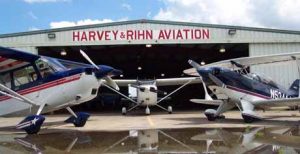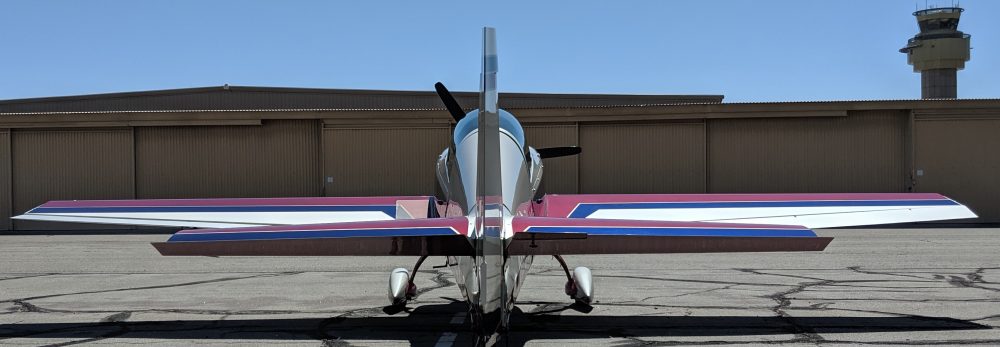In the early 1990s I found my family and I residing and working in Houston, but I never adapted to living there. Luckily, after a year and a half of this self enforced exile, I happened upon a small flight school in La Porte, Texas, not too far from my home, that actually rented out and gave flight instruction in a Pitts S2A. Now up until this point my only flight time had been in a Citabria and it had been a while since I had even done any of that. But I had always wanted to fly something like a Pitts; I don’t know why but this was my chance and I was otherwise going crazy in Houston. Now most everything that you read about a Pitts would lead you to believe that they are death traps and you have to be a Superman of a pilot to be able to fly one. I really wasn’t too sure about it but this was my chance to try.
The school was owned and operated by Debbie Rihn and Doc Harvey; I never met Debbie at the school; she had a regular job flying for Southwest, but did see her a couple of times at aerobatic competitions near Houston. I did meet Doc; I liked him; he was cool and he was a hell of a pilot. But my main contact was with my CFI, Mike, who first introduced me to flying a Pitts. I never wanted to fly aerobatics; the experience of the spin demonstration with Joe had scared me quite a bit; all I really wanted to do was find out if I could take the Pitts off and then land it; that’s it. But Mike said: “If you want to fly a Pitts, then you have to learn aerobatics”. There was no discussion; we strapped on parachutes and over the next several weeks I proceeded to have a 10 hour block of instruction on the basic aerobatic maneuvers and in the process learned how to land the thing; and, I learned that spins were actually a hoot. If you find yourself in the area, make some time to stop in.
Everyone has their favorite stories about their flight training days and learning to fly a Pitts has provided quite a few; I will never forget two of them from LaPorte. La Porte was non towered and I was not at all comfortable with that since most of my flying had been out of airports with control towers. The first memorable event had to do with the visibility, or the lack thereof, when flying a Pitts. Its damn difficult spotting other planes from inside a Pitts because of the blind spots; and, because it is so small, Pilots of other planes have a hard time spotting a Pitts in flight. I was in the pattern practicing landings and was followed by a Cessna also staying in the pattern; each of us was calling our turns and I just assumed that the lady pilot in the Cessna was well behind me. Mike was in the front seat, basically just along for the ride. I was on final only out about a half mile; I was still at pattern altitude but had just pulled the power back for the kamikaze approach to land. That’s when I heard the Cessna call: “….turning left base to final.” I knew that the Cessna was well behind me, but out of habit I turned left to look for the plane; when I saw Mike’s head casually turn as well, I ceased looking to the side and again concentrated on the approach. That’s when it happened: first the intercom came alive with “oh shit” blaring through the headset; simultaneously the throttle slammed forward and the stick came sharply back; Mike had the plane. Mike was very quiet for a long time but after he regained his composure, he was a able to describe in great detail what the Cessna and its pilot had looked like. Obviously the woman hadn’t seen us and I never saw her. I wasn’t really shaken up; the gravity of the situation hadn’t sunk in; Mike, however, was really shaken; he circled the field well above pattern altitude for several minutes before giving the plane back to me for landing. Mike had likely just saved my life.
But the next time it would be Mike who screwed up. We were downwind for landing, Mike announced that he was ducking down so that I would have a better sight picture of what the visibility was like without a passenger in the front seat; and with that he proceeded to unhook his seat belt and harness and moved down, completely out of sight. I need to digress. In an S2A, the rudder pedals for the pilot in the back seat are abeam the front seat; there is nothing surrounding these pedals to shield them from obstructions. Digressing further. My feet are big, my shoes are size 13; and I prefer to wear athletic type shoes that have wide soles. Because of the size of my shoes and the lack of protection around the rudder pedals, there was very little clearance between my shoes and the seat cushions in the front seat; unless they were perfectly centered in the front seat, these cushions would bind against one or both of my shoes restricting my ability to use the rudder pedals. Final digression. I was taught to fly with my feet placed on the lower portion of the rudder pedals in order to reduce the risk of inadvertently pressing on the upper portions which control the brakes; then when needed, the brakes could be operated by merely sliding my feet up to reach the upper portion. Now, with all of Mike’s twisting and turning to get out of my line of sight, he either dislodged and shifted the cushions or otherwise mashed some portion of his stout torso firmly against the sides of my feet. And I didn’t have a clue; the Perfect Storm approached.
In non aerobatic flight in a Pitts, the rudder pedals move very little; slight changes in pressures are all that is needed to achieve the desired results. And, while flying, if the pressure is a little bit “off” then a change of a few feet in altitude or a few degrees in heading is hardly noticeable and certainly not life threating. But when on the ground during take offs or landings in any taildragger, and especially in a Pitts, even slight changes in pressure on the rudder pedals have very dramatic effects and must be applied precisely, with authority and immediately when required. Our approach to land seemed normal; so did the initial touchdown. But at the fist sign of a swerve I knew something was wrong and I immediately knew the cause; I also knew there was no way to fix it other than to deal with it. But the rudder pedals were ineffective without massive amounts of pressure, The plane swerved from side to side of the runway; the wings rocked back and forth as the plane was over controlled. Fortunately I did not try to apply power and attempt a go-around; that surely would have resulted in a full blown crash. I tried to slide my feet upward to get to the brakes in the hopes of regaining some control only to discover that my feet were stuck in the lower position. Pulling both of my feet back, shifting them to a higher position, and then reapplying enough force to offset the cushions and Mike’s butt finally got the brakes to begin to take effect to steer and slow us down. And all the while not a peep was heard from Mike as he stayed neatly tucked out of sight. Only after we had come to a complete stop did Mike reappear and comment: “Wow, you certainly know how to make this exciting.” I was speechless.
It was in Texas that I first took my son, who was probably about eight at the time, somewhere around 1993 I believe, to a local aerobatic competition. We ran into Mike and he offered to let my son sit in the front seat of an S2A. At my son’s height at the time his eye level when sitting inside was well below the sides of the plane; it must have seemed like he was inside an enormous cavern and he had no way to see outside the plane. It would be well over a decade before either of us would be in another Pitts.
